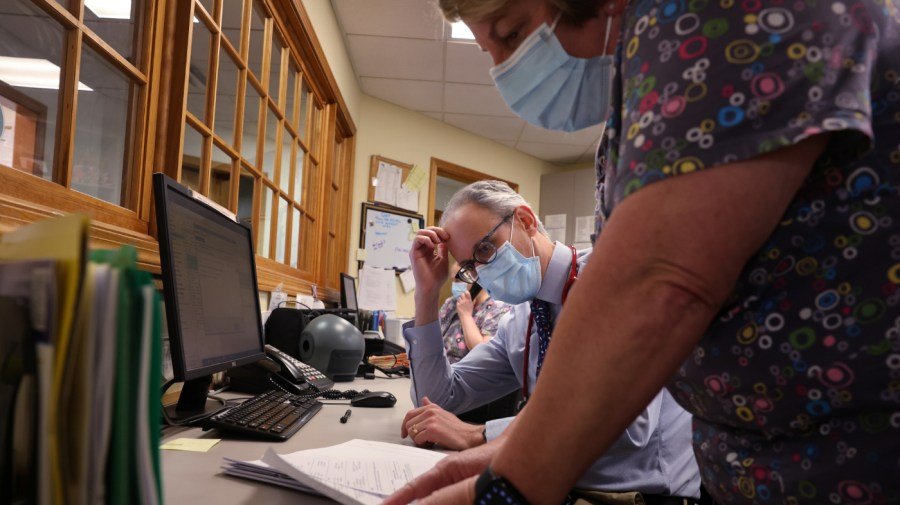
The second Trump administration has made it a core mission to cut spending on public health programs. But ironically, one agency in its crosshairs is pivotal to cost-effectiveness research in health care delivery.
The Agency for Healthcare Quality and Research, housed within the Department of Health and Human Services, is aimed at helping health care organizations and providers to deliver safe, high quality and equitable health care.
Despite this vital mission and its research support to evaluate the cost-effectiveness of health care measures, the Trump administration has proposed cutting $129 million from its budget — an overall 25 percent reduction.
This is in addition to an 80 to 90 percent reduction in staffing, with dramatic staffing cuts already having taken place.
These cuts fit within a broader pattern of the administration’s efforts to grind to a halt the work of agencies throughout America’s public health bureaucracy, whether through cuts to National Institutes of Health funding or the recent firing of the director of the Centers for Disease Control and Prevention.
The Agency for Healthcare Quality and Research employs three core competencies to advance its mission: It invests in health systems research, it develops tools, training and other resources to apply evidence to the practice of health care delivery and its data and analyses assist with health care decision-making.
With woefully insufficient staffing, the agency has limited capacity to distribute grants, let alone support its other work on preventive care.
Hobbling the Agency for Healthcare Quality and Research’s capacity is dangerous.
Contrary to the Trump administration’s assertion that its work is “wasteful or duplicative,” unlike other health agencies focused on diseases, it is the only federal agency focused specifically on the health care system and how health care is delivered, playing a critical role in patient safety.
What is the impact of government nutrition program participation on children’s health and health care utilization?
What is the impact of a state sepsis mandate on hospital mortality, health care utilization and cost?
How do state policies affect the prevalence, treatment and outcomes of pregnant women with opioid use disorders?
What was the impact of COVID-19 on drug shortages?
These are Agency for Healthcare Quality and Research-funded studies with findings that can be highly impactful in shaping health care delivery across the country.
In addition, the agency funds a number of predoctoral and postdoctoral training programs across the country, allowing for new generations of scholars to be trained in the field of public health and build careers conducting impactful health-related research.
In all, over $621 million in funds have supported health services research and training across the United States.
This research is not abstract academic analysis, but rather translates into better health outcomes and even lives saved. This includes a 21 percent reduction in hospital-acquired infections since 2010 and a 28 percent reduction in central line infections across the country, which saved the United States $28 billion in health care costs.
All thanks to Agency for Healthcare Quality and Research programs that we may no longer see under the Trump administration.
Another core function of the agency is to support the U.S. Preventive Services Task Force, the independent panel that reviews evidence and issues recommendations on preventive care such as cancer screenings and immunizations.
Recent recommendations include screenings for caregiver abuse of older adults, food insecurity, hypertensive disorders during pregnancy and breast cancer.
It provides the staff and scientific reviews that make the Preventative Services Task Force work possible, in addition to partnering with research organizations to synthesize evidence to inform the task force’s recommendations.
The ability to develop these recommendations is critical for health care access because, under the Affordable Care Act, preventive services with strong task force ratings must be covered by Medicare, Medicaid expansion and private insurers at no cost to patients.
The Trump administration has also targeted the Preventative Services Task Force by working to remove the entire panel, all while former task force members advocate to preserve the Agency for Healthcare Quality and Research.
It remains unclear how cutting a historically effective federal agency that has saved billions of dollars and tens of thousands of lives, while accounting for only 0.02 percent of the HHS budget, can be seen as useful to the United States economically or for its public health.
Instead, it looks like a short sighted move that weakens patient safety, undermines care for the nearly 140 million Americans enrolled in Medicare and Medicaid and leaves the country without its only dedicated source of health care delivery science.
What could be the rationale behind such cuts? One possibility is that the agency’s measures are seen as another layer of regulation and reporting for hospitals and insurers, and Trump’s deregulatory agenda finds it politically expedient to target them.
But this framing ignores the evidence. Unlike regulations that may simply add red tape, the Agency for Healthcare Quality and Research’s work has consistently turned oversight into lives saved and dollars returned to the health system.
Rolling back this kind of evidence-based accountability may appeal rhetorically to a deregulation platform, yet in practice it weakens patient safety, raises costs for Medicare and Medicaid and leaves the public’s health more vulnerable.
Alexander Sundermann is an assistant professor at the University School of Public Health, Department of Epidemiology. Miranda Yaver is an assistant professor at the University School of Public Health, Department of Health Policy and Management.


